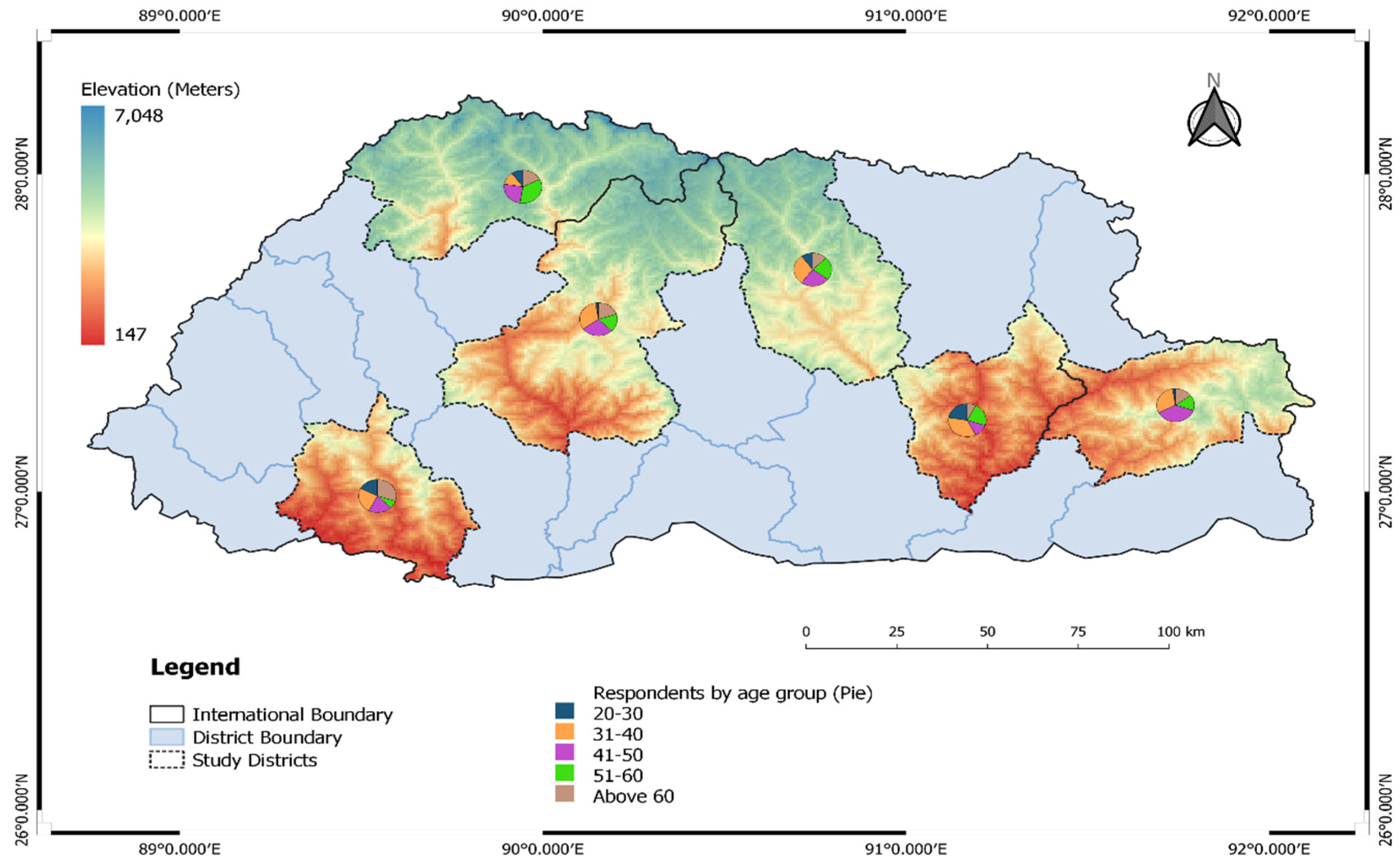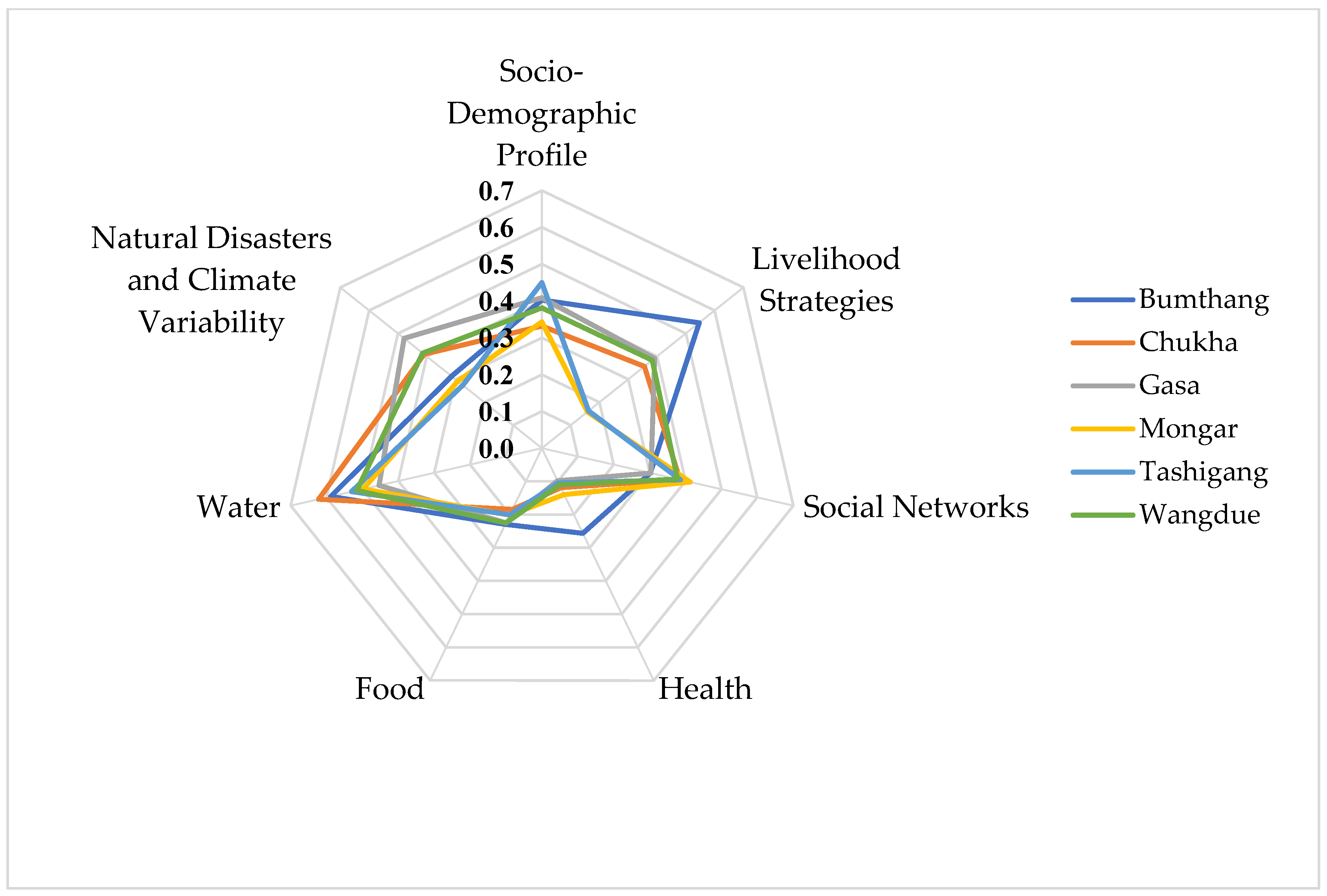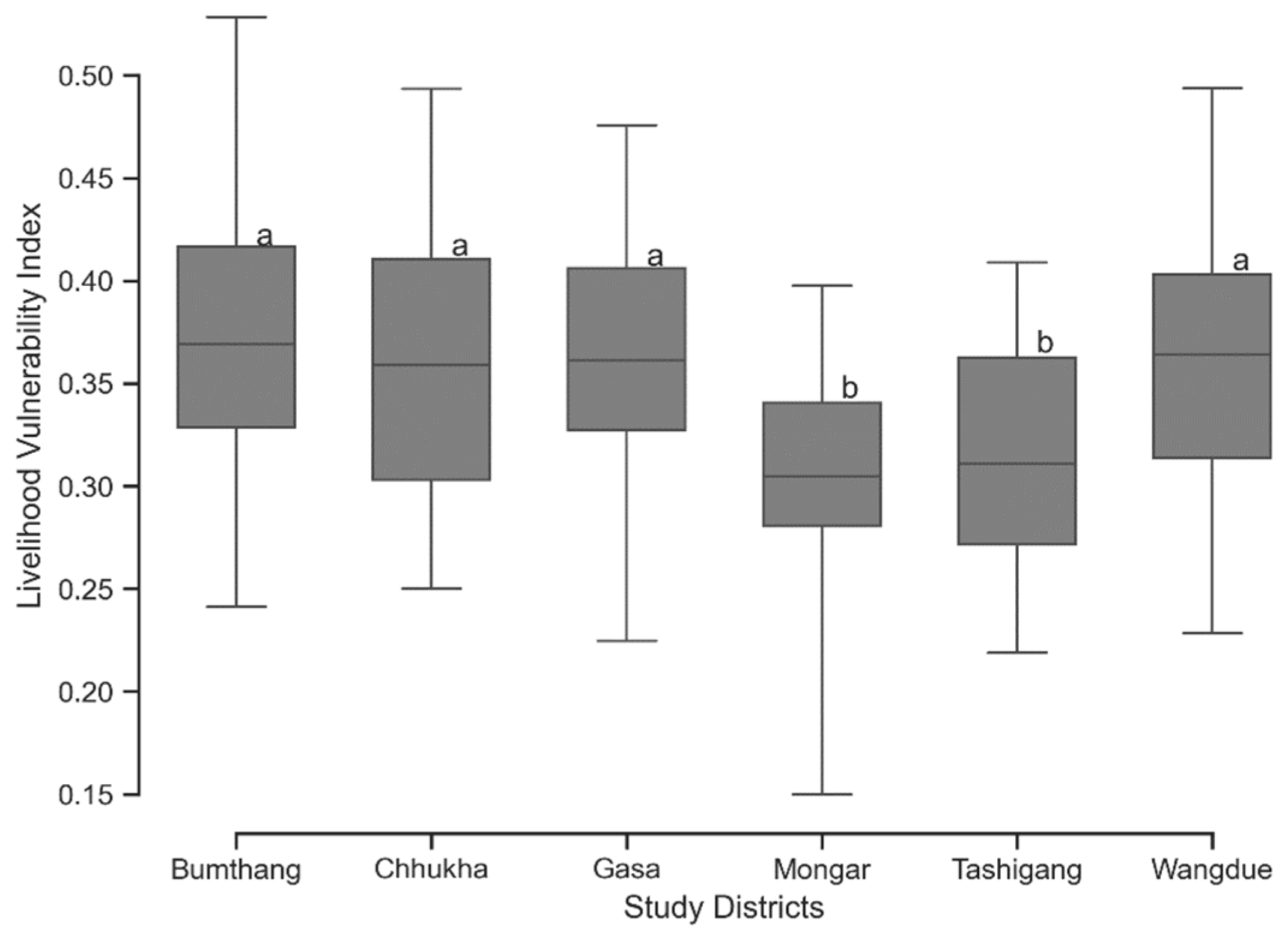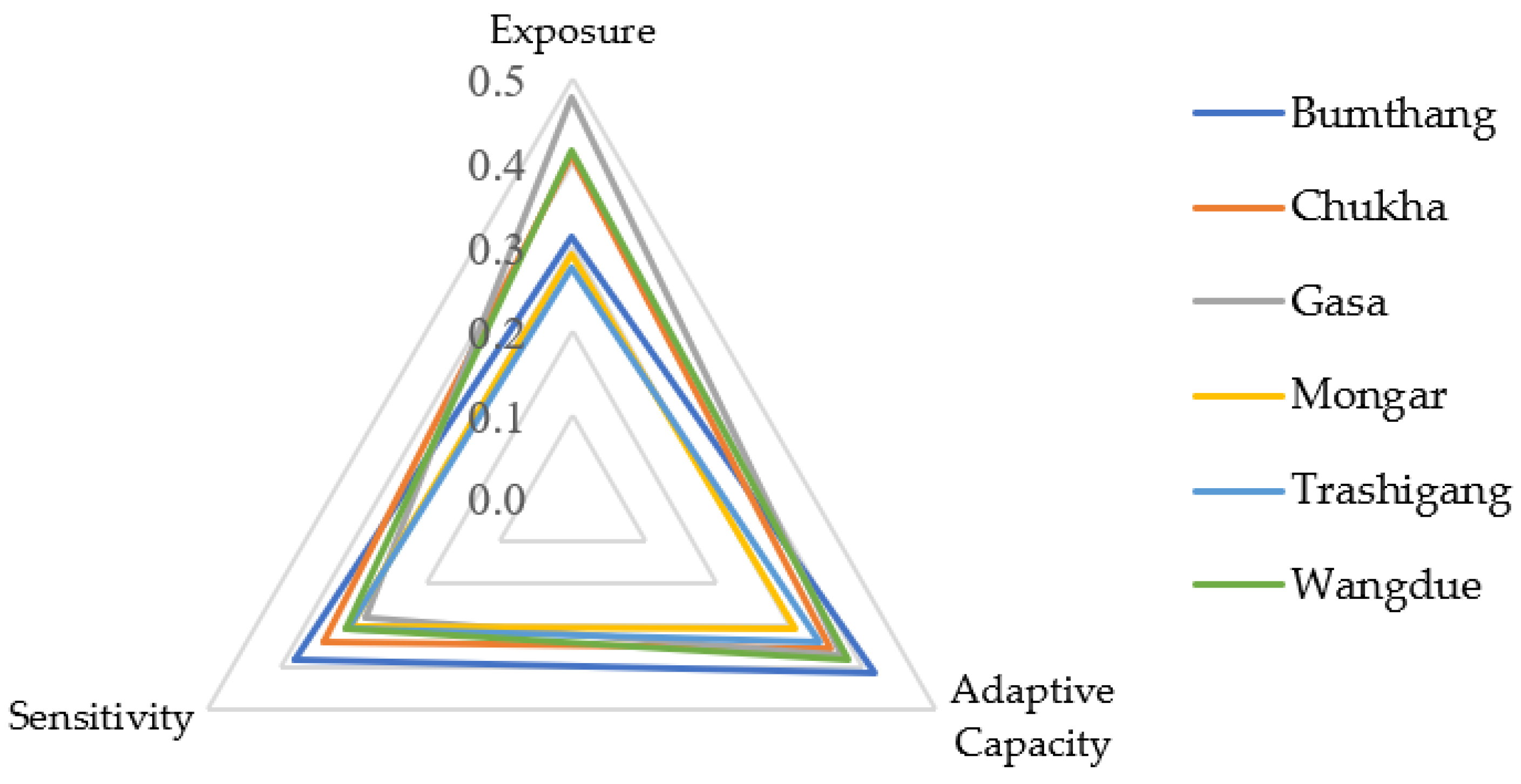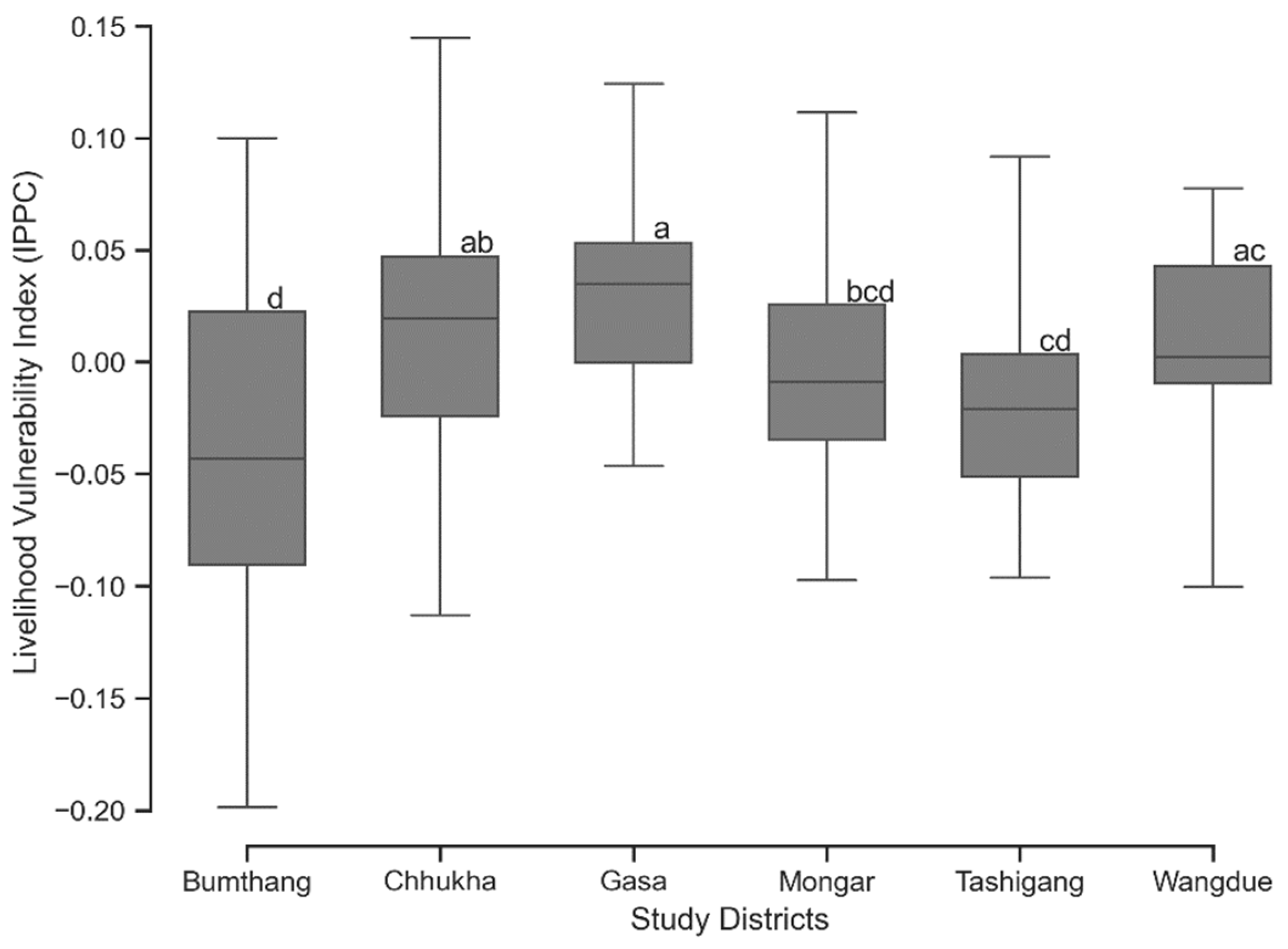1. Introduction
Despite its location in the fragile mountain topography of the eastern Himalayas, Bhutan has committed to the global community to remain carbon negative. The country has adopted a unique development philosophy of the Gross National Happiness (GNH) that accords the highest priority for the conservation of the environment. It is a less developed country where agriculture, livestock, and forestry sectors contribute 15.82% to the GDP [
1] but provide a major source of livelihood, engaging 50.8% of the population [
1]. Currently, 66% of the population resides in rural areas [
2] and depends on integrated subsistence family farming practiced under a typical mountain environment to eke out their livelihood [
3]. Bhutan’s location and geophysical setting make it highly vulnerable to the unprecedented impacts of climate change. A majority of the farming households are small-scaled subsistence farms with average landholdings of 0.1 to 3.6 acres. Further, the highly scattered settlements are mostly located in deep valleys, gorges, and rugged terrain, which makes sustainability of their livelihood very challenging even with minor disruptions [
3,
4,
5]. In addition, due to large topographical differences accompanied by huge altitudinal variation, erratic climatic natural hazards—such as glacier lake outburst floods (GLOF), flash floods, erosions, and landslides—have been predicted to occur and are likely to intensify in the future in Bhutan [
6,
7]. Typical characteristics of the mountain environment include fragile geo-ecology, marginality, inaccessibility, subsistence livelihoods, limited land resources, low productivity, and limited off-farm employment opportunities [
8]. In the rugged topographies and delicate mountainous settings, the amenities such as networks of accessibilities (roads), means of connectivity, and other infrastructure developments have been relatively poor, making them highly vulnerable to external stresses [
9].
Notwithstanding such difficulties, Bhutan had reduced its national poverty to 8.2% in 2017 from 23.2% in 2007; however, rural poverty (11.9%) dominates urban poverty (0.8%) [
5]. In terms of food consumption, 6.2% of the total 163,001 households are categorized as “not having enough food to feed their families” [
4,
5]. Historical evidence indicates that Bhutan has been severely affected by several flood disasters caused by cyclones and natural hazards. For example, Cyclone Aila completely destroyed 29 rural households and killed 12 people, besides damaging thousands of hectares of land across 17 districts [
10]. It has been projected that the majority of Bhutanese farmers are likely to succumb to the climate change impacts (hereafter referred to as ‘CCIs’) [
11]. Bhutan is expected to experience an alarming increase in temperature (by 0.8–3.2 °C) with a larger increase predicted in higher altitudes and a 10% to 30% annual increase in precipitation, respectively, according to recent forecasts [
12,
13,
14]. Despite the fact that Bhutan’s forest carbon sequestration is almost three times its greenhouse gas emission [
15], the country is facing major climate-related threats, particularly in climate-sensitive sectors, such as agriculture [
15,
16]. Further, a recent study in Bhutan reported that unpredictable weather was experienced by 79% of the farmers [
17].
Although assessments on the impacts of climate change on the agriculture and allied sectors have been undertaken, the vulnerability of farming communities’ livelihoods has not been assessed. The concept of livelihood is fast emerging and commonly used in contemporary studies on assessments of poverty and rural development [
18]. By definition, livelihood comprises the capabilities, assets (including both material and social resources), and activities required as a means of living [
19]. However, livelihood is often challenged by the vagaries of vulnerabilities and deemed sustainable only when people can effectively cope with and recover from stresses and maintain or enhance its capabilities both now and in the future, without depleting the resource base [
18,
19,
20]. Unless these vulnerabilities are addressed, livelihood will be challenged and thus will impact their livelihood assets [
21]. Therefore, an understanding of vulnerability is the integral component required to identify and characterize appropriate adaptation measures and enhance the resiliency of the poor who own limited quantities of livelihood assets [
22]. However, addressing the vulnerabilities is not straightforward; rather, it involves varied disciplines and expertise. For example, some of the prominent research fields that it covers are ecology, public health, sustainability science, land-use change, and climate change [
18]. From the development perspective, vulnerability has its roots in famine, poverty, food insecurity, unemployment, inequality, political economy, and sociocultural norms [
23,
24]. Owing to this complexity, the study of vulnerability demands multidisciplinary approaches but context-specific analysis using context-specific indicators [
23].
For this study, vulnerability is described as a state of defencelessness to secure livelihood due to the limited ability of an individual or group to counteract the external shocks that they face in their day-to-day life [
19,
25]. Of various such stresses, CCIs have been considered one of the primary factors affecting the livelihood of the marginal rural farming households around the world [
26]. This is because CCIs pose a direct threat to the limited and friable livelihood assets that most smallholder farmers generally possess at the household level and to their ecological systems or surroundings [
19,
27]. Without qualification, the climate is one of the most fundamental external factors influencing agriculture growth and development [
28]; however, the CCIs have persistently hindered the sector’s growth resulting in increased vulnerability, especially amongst the smallholder farm households of the global south [
29,
30]. Due to the households’ minimal adaptation capacity, their livelihood and economies are further predicted to be aggravated and to incur severe consequences due to the climate change impacts [
31,
32].
The Intergovernmental Panel on Climate Change (IPCC) describes climate change as “the result of the interaction between the biophysical drivers (including climatic exposure) and the function of the system’s sensitivity and adaptive capacity” [
32,
33]. The change in global climate has been reported to be a result of both human activities and natural variabilities [
34].
Global surface temperature is projected to increase 1.5 to 2.5 °C by the end of the twenty-first century, with higher frequencies and longer durations of heatwaves [
35]. Such impacts of climate change have been recognized as one of the serious obstacles in attaining food and nutrition security or achieving major global sustainable development agendas, especially in the global south [
35,
36]. From a continental view, the fourth assessment report of the IPCC stated that by the 2050s, 300 to 600 million Africans would face acute vulnerabilities, predominantly in the northern and southern part of the continent, due to increased water stress (drought) for both drinking and farming [
32]. Given the very low adaptive capacity accompanied by acute levels of poverty and limited abilities to mitigate CCIs, Sub-Saharan regions of Africa are considered one of the most vulnerable regions in the world [
34,
37]. In Africa, a majority of the farmers are heavily dependent on climate-sensitive sectors such as agriculture, so they are the most vulnerable due to a lack of means to appropriate adaptation measures and counteract CCIs [
38,
39].
Scenarios of CCI in Asia are similar to that of its African counterparts, with most of the countries equally dependent on agricultural farming and natural-based resources for their livelihood [
40]. About 5% to 30% crop yield decline is projected in most parts of Asia due to CCI [
30]. Freshwater availability, such as the large river basins of Changjiang, is likely to decrease due to CCI, severely affecting approximately 1.2 billion people who are largely dependent on agriculture and related farming by the 2050s [
30,
40]. Intriguingly, the Indian subcontinent alone would experience an overall temperature increase of 1 to 4 °C, an increase in precipitation of 9% to 16%, and increases in other erratic occurrences of extreme events such as droughts, floods, cyclones, and landslides by the 2080s, all of which are projected to disproportionately affect small-scale farming households [
41]. In particular, the Indo-Gangetic Plains of India, that account for about 14% to 15% of the global wheat production, are likely to incur yield loss of 8% to 36% due to heat stress and erratic precipitation [
42], impacting millions of people worldwide. With such scenarios developing and overall agriculture yield declining, the current 55% of the Indian population, who are largely dependent on agricultural sectors, is likely to face even higher risks to the CCI in the future [
43]. Similarly, Karki et al. [
44] have reported the rapid retreat of glaciers (>30 m/year), increase in temperature (>0.060 °C), and an increase in irregular frequencies of weather variabilities in Nepal. In Bangladesh, the two major sources of livelihood of the farmers—rice and fish farming—have been hit hard, resulting in a loss of 0.5 million tons of rice annually and sharp declines in fish production due to prolonged floods and salinization caused by climatic anomalies in recent past [
45,
46,
47].
Of the various crop-based farming systems in Bhutan [
48], the typical mountain-based potato farming system has played a vital role in supporting the livelihood of farmers since its formal introduction in the 1970s [
49]. From its humble beginnings as a homestead garden crop [
49], the potato has become the most widely cultivated, consumed, and traded crop in Bhutan [
50,
51]. It is currently cultivated by 34,000 rural households, mostly in the temperate agroecological zone, for their livelihood [
4,
51]. The revenue generated through the sale of potatoes was BTN 709.81 million in 2019 (USD 1 ≈ BTN 72) [
52]. The income farmers receive from the sale of potatoes directly helps them purchase their staple food products, such as rice and other household necessities [
50,
53]. Within a short span of time, this crop was adopted by many Bhutanese farmers [
54]; however, the CCIs have not spared the potato crop and instead have brought about substantial consequences in the overall agricultural sector in Bhutan [
15,
16]. Further, studies have forecasted that the land currently suitable for potato cultivation will become unsuitable by the 2050s, and the high-elevation areas (>3000 masl) will be affected due to larger temperature increases [
12,
55]. Against this backdrop, this paper attempts to understand the vulnerabilities caused by the CCIs at a household level in the communities whose livelihood hinges on a fragile mountain-based potato farming system, using the lens of a livelihood vulnerability framework/index. Accordingly, the objectives of the study are: (1) to assess and ascertain the vulnerability status of mountain-based potato growing farmers across the six districts in relation to climate change impacts; and (2) to generate empirical evidence and information on the impacts of climate change on livelihood source of the farming community using LVI approaches that will serve as a basis for informed decision making in future.
3. Results
3.1. Demographic Profile of Surveyed Respondents
Survey participants were farmers across the six study districts. Approximately 69.17% identified as female (30.83% as male), and just over half were between 31 and 50 years old (52.09%). A majority of the respondents were illiterate (59.17%), and only 0.42% had a diploma or higher educational qualifications. The average family size among respondents was 7.5 members per household, and the average landholding was 3.17 ha per household. To ensure the reliability of the information, only respondents that were 20 years and above were considered for the individual interview (
Table 4).
3.2. Livelihood Vulnerability Index (LVI) for the Six Study Districts
The overall LVI comprising of major components (composite) and the subcomponents for each of the study districts are presented in
Table 5. In terms of the SDP major component, the Tashigang district was the most vulnerable (with an index value of 0.450), followed by Gasa (0.409), Bumthang (0.403), Wangdue (0.381), Mongar (0.343), and the least vulnerable Chukha (0.332). On the ‘dependency ratio’ subcomponent of SDP, the highest was for the Wangdue district (0.24), and the least was Mongar (0.13), indicating the respondents in the former district had a much higher percentage of ‘inactive’ household members. Tashigang exhibited the highest percentage of the respondents reporting female-headed households (90%), while the lowest was Chukha (50%). The average ages of heads of households ranged from 36 to 47 years across all the districts. Tashigang district reported the largest percentage of heads of households who had not attended school (73%), with all other districts falling between 50% and 65%. Orphans are very uncommon, with only Bumthang (0.08) and Wangdue (0.05) reporting an orphan in their households.
Regarding the LS major component, Bumthang district demonstrated the highest vulnerability score (0.546) and Mongar (0.158) the lowest—a substantially larger spread than for the SDP major component. This aggregate disparity was driven by similar disparities in each of the subcomponents. For instance, Bumthang district reported the highest percentage of households with a family member working outside the community or country (73%), while Mongar reported only 15%. Likewise, 53% of households in Bumthang, Gasa, and Wangdue reported not receiving any external remittances, compared with only 3% of households in Mongar and Tashigang districts, indicating a much stronger degree of vulnerability in the latter districts. Mongar reported 43% of households being dependent solely on agriculture for income, which, taken in conjunction with the remittances results, indicates compounded vulnerability. Chukha, on the other hand, had a high dependency on agriculture (63%), but 28% of households reported receiving remittances, hence decreasing susceptibility for localized risks. In terms of the agriculture livelihood diversification index, Bumthang showed the highest index value of 0.38, indicating the lowest levels of diversification activities among the study districts (and hence the highest levels of vulnerability).
Analyzing results for the SN major component, we see a tighter distribution of vulnerabilities on aggregate than for the LS major component. Average help received-to-given ratios were similar across study districts, as were money borrowing-to-lending ratios. While rates differ across districts regarding neighbor relations, most report low levels of poor relationships. The one subcomponent demonstrating a marked disparity among districts was the number of households reporting not having received any local government assistance in the past 12 months. Mongar district reported at the highest rate (73%) and Bumthang at the lowest (13%). That alarmingly high rate for Mongar (and the similar rate of 65% for Tashigang) warrants further examination.
The vulnerability scores for the health major component at the aggregate level were highest for Bumthang (0.256) and lowest for Gasa (0.098). These results were driven by the responses in all four subcomponents, where Bumthang remained at or near the top and Gasa at or near the bottom (with the exception being a chronic illness, where Gasa scored the second highest at 25%). Tashigang (0.104) and Wangdue (0.110) also recorded low levels of vulnerability for the heath component at the aggregate level. For the food major component, districts were clustered very closely. Between 80% (Chukha) and 98% (Bumthang) reported dependence on the family farm for food. None reported saving crops, and only Bumthang reported saving seed (5%).
Whereas overall vulnerability levels were low for health and food, the vulnerability was much higher for water. Indices ranged from 0.622 for Chukha to 0.454 for Gasa. All households across all study districts utilized natural water as their primary water source. For Bumthang, 65% of households reported water conflicts, and 90% reported an inconsistent water supply, in both cases the highest for those respective subcomponents. Chukha exhibited water shortages, which are a major vulnerability for agricultural communities. By comparison, only 10% of households in Gasa reported water shortages.
Last, the NDCV major component also demonstrated some disparity across districts, with vulnerability scores ranging from 0.479 (Gasa) down to 0.275 (Tashigang). Notable subcomponents included households not receiving early warnings for natural disasters (90% for Gasa compared with 18% in Mongar and 28% in Tashigang), pest, or disease outbreaks (78% for Gasa compared with 43% for Mongar and 45% for Tashigang) and more hail/windstorms and erratic rainfall (48% and 78%, respectively, for Gasa and 20% and 38% for Tashigang, respectively). More evidence of climate change and the absence of an early warning system indicate considerable risk for districts of Gasa, Chukha, and Wangdue.
Considering the overall LVI for the seven major components aggregated for the six study districts, we observe the highest vulnerability levels for Bumthang (0.375) and Gasa (0.365) and the lowest for Mongar (0.302). The complete LVI is illustrated in
Figure 2. The integrated results of the overall seven major components showed that the water major component is the most vulnerable, and health is the least vulnerable (
Table 5).
Further, the aggregated LVI of the seven major components based on the Kruskal–Wallis H test and multiple comparison analysis showed that the Tashigang and Mongar districts were less vulnerable than the other four (
Figure 3), and those results were highly statistically significant (H = 42.80,
p < 0.001).
3.3. LVI-IPCC for the Six Study Districts
The LVI-IPCC models yielded fairly dissimilar but captivating results (
Table 6). The vulnerability triangle depicts the scores of the contributing factors—exposure, adaptive capacity, and sensitivity, respectively—for each of the study districts (
Figure 4). A higher value for the vulnerability index represents higher vulnerability; however, negative values of the vulnerability index do not mean that the districts are not vulnerable—it merely indicates they are comparatively less vulnerable than the others. Accordingly, Gasa (0.479) was the most exposed to CCI, with the least exposed district being Tashigang (0.275). Bumthang was the most sensitive to CCI (0.380) but with the highest adaptive capacity (0.416) among the study districts. On the other hand, Gasa (0.304) was the least exposed, and Mongar (0.333) had the lowest adaptive capacity.
Unlike the findings of the LVI, the overall LVI-IPCC indicated that the Gasa district (0.030) was the most vulnerable among the six study districts to CCI, while the Bumthang district (−0.039) was the least so, which stems largely from the latter’s high adaptive capacity.
Further, the LVI-IPCC results of the three contributing factors based on the Kruskal–Wallis H test and multiple comparison analysis showed significant (
p < 0.05) differences between the districts (
Figure 5).
Similar to the combined LVI results, when we examine the statistical differences among the study districts for the combined LVI-IPCC, our post hoc analysis indicates the following patterns (
Figure 5): Bumthang district was statistically different to Chukha, Gasa, and Wangdue; whereas, Chukha was significantly different from Bumthang and Tashigang only. Gasa exhibited significant differences with Bumthang, Mongar, and Tashigang. Mongar was significantly different from Bumthang only, and Tashigang was significantly different from Chukha and Gasa. Lastly, Wangdue district was significantly different from Bumthang only. Generally, the study districts were statistically different with overall test statistics of (H = 38.89,
p < 0.001).
